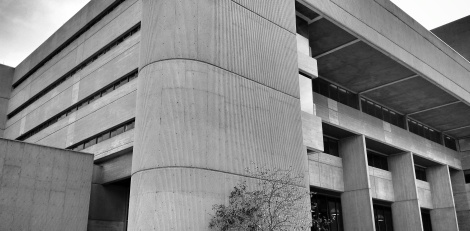I have to confess, I’m not a huge fan of the D. B. Weldon Library’s architecture. Although not downright ugly, I remember wincing a little at first sight over my open-house campus tour, especially after seeing the iconic University College and Middlesex College in their full Gothic glory. After starting my MLIS, however, I can’t help but noticing the ubiquity of the same “brutal” architecture among some high-profile libraries including:
– The Birmingham Central Library (now closed) in England
– The Claire T. Carney Library at the University of Massachusetts Dartmouth
– The Countway Library of Medicine at Harvard
– The Herman B Wells Library at Indiana University
– The W.A.C. Bennett Library at Simon Fraser University
– The McLennan-Redpath Library Complex at McGill
Time for a closer look beyond those cement walls for the architectural heart and soul of the Weldon bunker!
Named after Lieutenant-Colonel Douglas Black Weldon (1) in commemoration of his long service and generosity to Western, the D. B. Weldon Library was built from 1968 to 1972 by architects Ronald E. Murphy and John Andrews, and was officially opened on June 1, 1972. (2, 3) The angular, double-diamond-shaped main building is rounded with six corner stair towers flanking its five horizontal cement bands. Typical of the Brutalist architectural style, pre-stressed, post-tensioned concrete (2) dominates the 265,000 sq. ft. library structure. (4) A variety of windowless, box-like substructures project along its lower levels on the east. Once inside, the imposing, egg-crate concrete ceiling commands immediate attention.
But what exactly is Brutalism? Originated in England and said to have its root in the Swiss-French architect Le Corbusier’s purely descriptive phrase béton brut, Brutalism is more than just intricately textured “raw concrete” and awe-striking geometries overhanging with blocks, podiums and articulations. It is an architectural philosophy often associated with the postwar austerity and a socialist utopian ideology. (5) Flourished from the late 1950s to the mid 1970s, Brutalism afforded a relatively inexpensive solution to climate control in large buildings (6) while presenting itself as the new ideal of social and political transparency in the rebuilding efforts after World War II. (7)
From “architectural crimes against humanity” to the myth of using Brutalist designs as a means to thwart student riots on campus, Brutalist buildings have perpetually been criticized and described as cold-hearted, uncommunicative, relentless, claustrophobic, out-of-place and insensitive to human interactions. For one, I’ve become disoriented countless times in Weldon due to its symmetrical floor plan and lack of window openings. Far from its apparent totalitarian and top-down commanding character, however, Brutalism proponents have always underlined the style’s monumental aspirations, uncompromising honesty and progressive, anti-bourgeois nature. Unquestionably inventive, some buildings could no doubt be playful.
During Weldon Library’s conceptualization phase back in 1966, a “Library Ideal” plainly articulated in a special edition of The University of Western Ontario News (Vol. 2, No. 12, October 24, 1966):
The success of the new Main Library Building will depend on a clear conception of the function of this specific library and on an architectural solution that will ensure efficient operation, provide flexibility of space, and be direct, logical and easily understood in its arrangement.
Furthermore, it must provide an environment that is friendly, intimate, warm, pleasant and conductive to study. It should not be a cold monument but a live, vital building. The design must basically reflect a solution of its interior functions.
The library should have a special quality that makes it distinct from classroom buildings and clearly establishes it as the academic heart of the campus.
On the occasion of the library’s official dedication on October 29, 1971, David B. Weldon, the son of Lieutenant-Colonel Douglas Black Weldon, commented on the new architecture and pointed out that “a building is only as great as the spirit, enterprise and devotion of the people who work in it.” (8)
Whether that library ideal above was fulfilled is open to discussion. Certainly controversial at the time of construction because of its stark architectural contrast compared to the rest of the campus, Weldon Library’s unconventional acumen went beyond its concrete structure and continued to this day, for example, with the establishment of the Pride Library in 1997. Apart from the programming, staff and librarians, a library is nothing but a static collection of books without its users and for better (comically @ClubWeldon) or for worse (students’ boozing misbehaviour), students, including myself, will always have “fond” memories of their library by the time they graduate. But until then, please let me get on with that elevator without a 10-minute wait!
______________________________________
The backstory: an afternoon (or two) at the archives…
Reference
1. http://en.wikipedia.org/wiki/D._B._Weldon_Library#Colonel_D._B._Weldon
2. http://www.rocreport.uwo.ca/?p=117
3. “Architect John Andrews will Assist Ronald E. Murphy in Design of New Main Library.” U.W.O News, Vol. 2, No. 26, February 9, 1967. p. 12.
4. Murphy, Ronald E. and John Andrews. “D. B. Weldon Library, University of Western Ontario, London.” The Canadian Architect, November, 1972. p. 26-27.
5. http://www.saylor.org/site/wp-content/uploads/2011/05/Brutalist-architecture.pdf
6. http://www.ontarioarchitecture.com/Brutalist.htm
7. https://nplusonemag.com/online-only/online-only/the-other-modernism/
8. “D. B. Weldon Library Officially Dedicated.” UWO News, Vol. 7, No. 19, November 4, 1971.
Acknowledgement
Thank you Anne Daniel for her help in retrieving those two boxes of hidden treasure on Weldon’s history at the Archives and Research Collections Centre.




















Siu, thanks for the very interesting read. I’m not a fan of brutalist architecture but it was cool reading about the intent behind Weldon’s design.
LikeLiked by 1 person
Great shots, Siu. You really traveled all over to get these!
LikeLiked by 1 person
Yeah, that was my procrastination over research week. Now kind of regretting it with all my REAL assignments sigh…
LikeLike